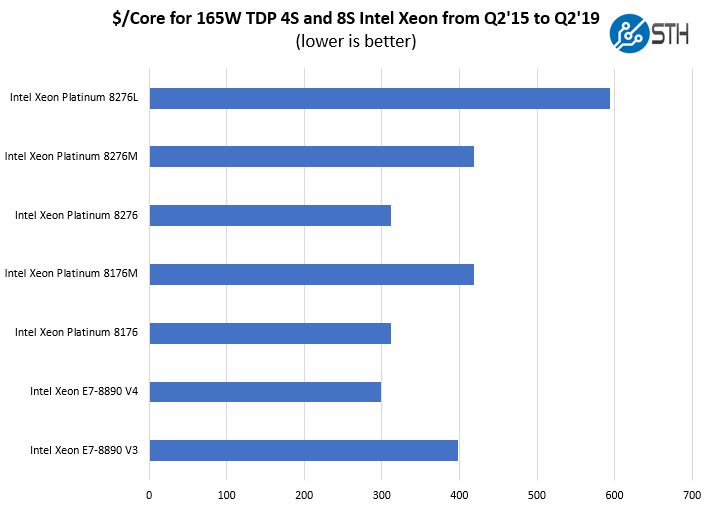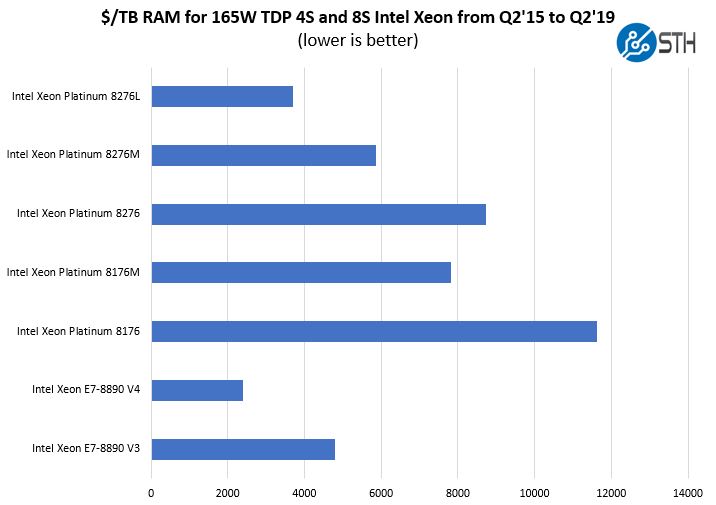Quad Intel Xeon Platinum 8276L Market Positioning
Thes chips are not released in a vacuum instead, they have competition on both the Intel and AMD sides. When you purchase a server and select a CPU, it is important to see the value of a platform versus its competitors.
Quad Intel Xeon Platinum 8276L v. Intel Alternatives
There is a single reason to use the Intel Xeon Platinum 8276L versus other alternatives in the quad socket configuration. That is simply that you want a lot of cores and RAM. We will note, that the vast majority of users will be better off with quad Intel Xeon Platinum 82xx machines than with the Platinum 9200 series. The Intel Xeon Platinum 82xx series has broad industry support while the Platinum 9200 virtually no OEMs support.
One can get by using Intel Xeon Gold parts in 4P configurations, however, not with 28 cores at these clock speeds, so there is little competition below in the stack.
When looking at the Intel Xeon Platinum 8276L versus the Intel Xeon Platinum 8276, the only reason to pay more than twice as much on the “L” is that you want to build a system with a lot of memory. Otherwise, it is hard to recommend. We do not see this configuration, as tested with the “L” part selling for less than $100,000 before support, licensing, and data center costs.
If we take a look at the 165W Intel Xeon generations capable of four and eight socket operation from the Q2’2015 Intel Xeon E7-8890 V3 to the Q2’2019 Intel Xeon Platinum 8276L and today, this is what the picture looks like for simple $USD/ core:

You can see that the Intel Xeon E7-8890 V4 offering 33% more cores at the same price point over the Intel Xeon E7-8890 V3 was the biggest jump. The Intel Xeon Platinum 8176 and Platinum 8276 add four more cores at a slight price premium but close enough that we see this as a segment. The Platinum parts have four more cores, similar base clocks but significantly higher turbo frequencies, plus all of the new microarchitecture enhancements.
Since this is a review of a “L” part, the Intel Xeon Platinum 8276L, we are looking at a high memory SKU. In terms of $USD/ TB of RAM supported, we get a very different picture:

The Intel Xeon Platinum 8276L actually looks like the best deal since the Intel Xeon E7-8890 V4 here. One also gets a lot of platform enhancements and we have seen significantly lower power consumption (non-AVX-512) from the newer Xeon Platinum parts. On the other hand, if you simply wanted to stuff a system with 12TB of RAM, the Intel Xeon Platinum 8890 V4 CPUs would actually save one $18,000 over the Platinum 8276L based on list prices. That $18,000 would be dwarfed by memory costs, and the newer chips can use Optane DCPMM, but it is still an intriguing proposition.
Quad Intel Xeon Platinum 8276L v. AMD EPYC Alternatives
AMD, at present, does not have anything in its first AMD EPYC generation that can compete with this. Limited to two sockets and 2TB of memory per CPU and 64 cores per system with the AMD EPYC “Naples” generation, AMD does not have a direct answer for this. The high memory capacity and multi-CPU scaling capability of the Intel Xeon Platinum 8276L is beyond what we would typically see from AMD in this generation, however, AMD EPYC “Rome” generation is coming soon with some transformative changes.
Quad Intel Xeon Platinum 8276L v. Arm and Power Alternatives
On the Arm side, Huawei is making a push with its Huawei Kunpeng 920 however it is targeting dual-socket servers, much like we saw with the Cavium/ Marvell ThunderX2. The Huawei part is also focused more on the company’s domestic market and we have not heard from sources outside of Huawei of an enormous amount of customer interest. Ampere eMAG is still a single socket solution until we see eMAG 2.
IBM Power9 has features that can compete with the quad Intel Xeon Platinum 8276L. For many higher-end applications in the quad-socket, high-memory space, the Power9 is the go-to option, albeit usually with a price premium attached.
Final Words
Overall, the quad Intel Xeon Platinum 8276L solution is excellent, albeit costly. Using a large piece of 14nm silicon for a 28 core die means that these are some of the most advanced and perfect CPUs that Intel is creating right now, and the company expects a premium for that. Further, with the “L” Intel is pushing into territory where more of the system cost is dictated by memory, potentially Optane DCPMM, instead of the chips themselves, and Intel adds a markup for that bridging the gap between it and IBM Power.




Here, one can see very strong performance here. ???
Hi,
When you are talking about STH budgets and pricing, are you suggesting you are actually purchasing these systems retail just to review them?
Shouldent Intel (or the other brands) be providing you with samples?
Navi
Hi Navi – we purchase six figures worth of hardware each year in addition to what vendors supply for reviews. It takes a lot to do this testing. Just the data center costs we have are well over $50K annually using low cost providers.